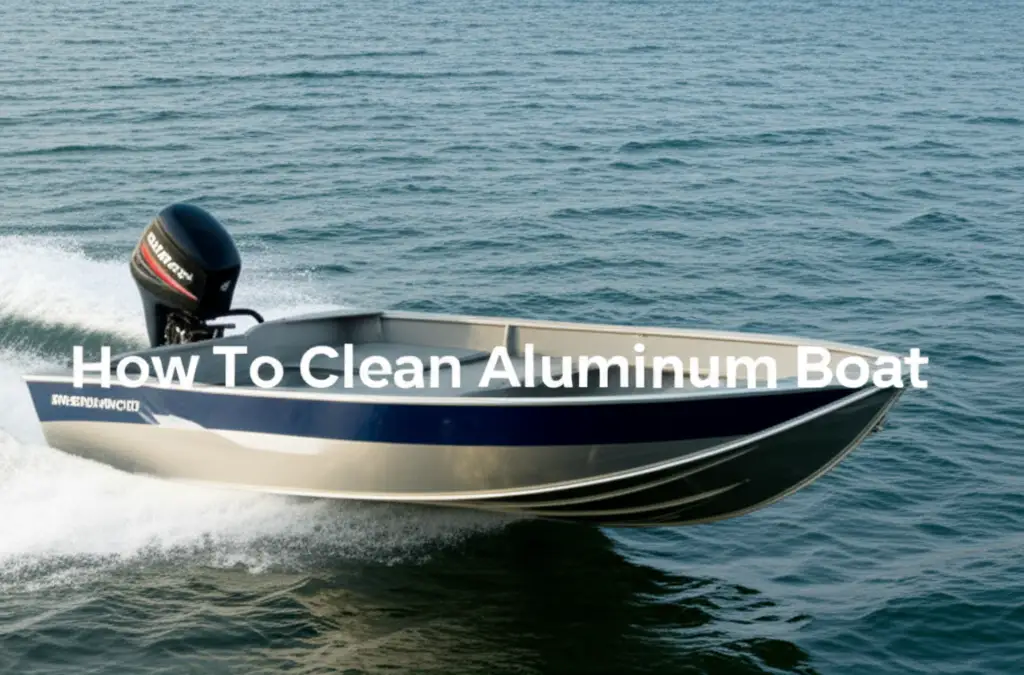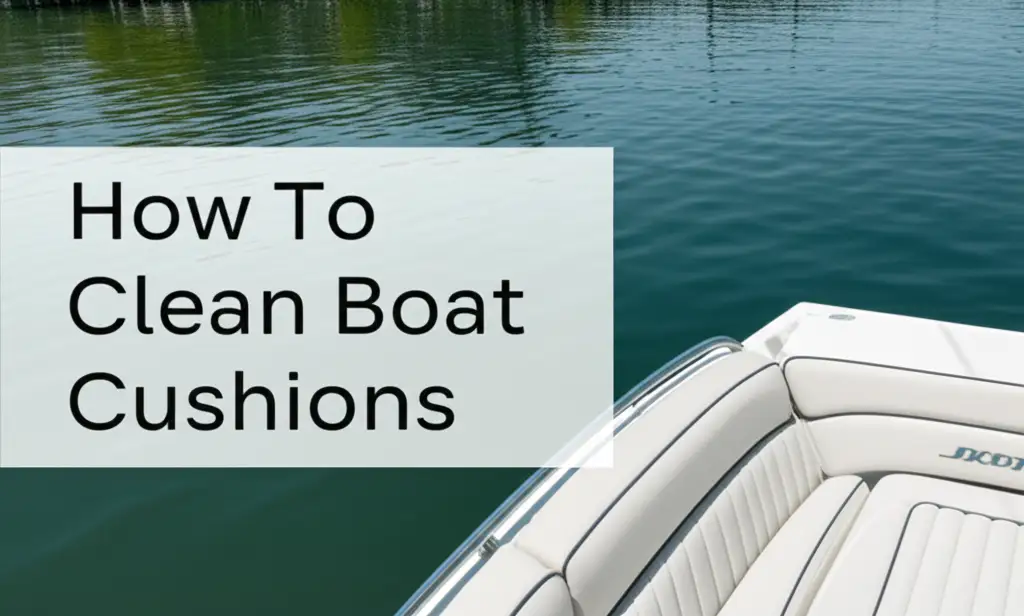· Boat Maintenance · 17 min read
How To Clean Mold Off Boat Seats

Restore Your Boat Seats: How to Clean Mold Effectively
Is your boat ready for the water, but its seats tell a different story? Mold can quickly take over boat seats, turning a fun day into a chore. I understand the frustration of seeing those unsightly spots appear. It makes your boat look old and uncared for.
Cleaning mold off boat seats is a necessary task for any boat owner. This guide will show you how to clean mold off boat seats thoroughly. We will explore various cleaning solutions, from simple DIY mixtures to specialized products. We will also cover prevention tips to keep mold from returning. You can restore your boat’s appearance and extend the life of its upholstery. Let’s get your boat seats looking new again.
Takeaway
- Identify mold type and gather appropriate safety gear.
- Choose between DIY solutions like vinegar or commercial mold removers.
- Apply cleaner, scrub, rinse thoroughly, and dry seats completely.
- Implement ventilation and protective measures for prevention.
To clean mold off boat seats, first identify the mold type, then choose a suitable cleaner like a diluted bleach solution, vinegar, or a specialized marine product. Apply the cleaner, scrub the affected areas, rinse thoroughly with fresh water, and allow the seats to dry completely to prevent re-growth.
Understanding Boat Seat Mold
Boat seats often become victims of mold and mildew. This happens because boats operate in damp environments. Mold is a type of fungus that grows in humid, warm, and dark places. Boat seats, especially vinyl or marine-grade fabric, provide a good surface for mold to latch onto. They trap moisture easily.
Mold can look like fuzzy patches or simple black spots. It can be green, black, white, or even pink. Understanding what causes mold helps in fighting it. I know how frustrating it is to see mold ruin a boat’s interior. We need to tackle this problem directly.
Why Mold Grows on Boat Seats
Mold needs three things to grow: moisture, warmth, and food. Boat seats offer all three. The marine environment provides constant humidity. Boats often sit unused, allowing the air to become stagnant. This creates warm, dark conditions.
Boat seat materials themselves can be a food source. Dirt, skin oils, sunscreen, and spills on the seats feed mold spores. These spores are everywhere in the air. Once they land on a damp seat with food, they start to grow. That is why cleaning is so important.
Common Types of Mold on Boats
Different types of mold appear on boat seats. Black mold is very common. It often appears as tiny black dots or larger dark patches. This type can be tough to remove. Green or white mold may also show up. They are usually less aggressive than black mold.
Mildew is another common problem. It often looks like a white, powdery, or gray, fuzzy growth. Mildew usually sits on the surface. Mold tends to root deeper into the material. Both need cleaning. I have seen many boat owners confuse the two. Knowing the difference helps you pick the right cleaning method.
Essential Tools and Cleaning Solutions
Before you start cleaning, gather your tools and choose your cleaning solution. Having everything ready saves time and effort. I always prepare my workspace first. This ensures a smooth cleaning process.
You will need a few basic items. These include protective gloves, safety glasses, and a mask. Mold spores can irritate your lungs. A soft-bristle brush is essential for scrubbing. Microfiber cloths or sponges work well for wiping. A bucket for water and a spray bottle for solutions are also helpful.
DIY Mold Removal Solutions
Many effective mold removal solutions are already in your home. These DIY options are often gentle and cost-effective. I prefer to start with these methods for lighter mold.
- Vinegar Solution: White vinegar is a great natural mold killer. It is non-toxic and biodegradable. Mix equal parts white vinegar and water in a spray bottle. Spray it directly onto the moldy area. Let it sit for 10-15 minutes. Then scrub and rinse. For more tips on this versatile cleaner, see our guide on how to clean with vinegar and baking soda. I find this solution works well for mild mold.
- Bleach Solution (for stubborn mold): Bleach is powerful for killing mold and removing stains. However, use it with caution. It can fade colors or damage some materials if not diluted properly. Mix 1/4 cup of bleach with one gallon of water. Test it on an inconspicuous area first. Apply it carefully. Do not use bleach on colored fabrics unless you are sure of its compatibility.
- Baking Soda Paste: Baking soda helps absorb odors and can scrub away mold. Mix baking soda with a little water to form a paste. Apply it to the mold, let it sit, then scrub. Rinse thoroughly. This is a gentle abrasive.
- Borax Solution: Borax is a natural mineral. It is a good mold inhibitor. Mix one cup of borax with one gallon of hot water. Stir until dissolved. Apply it to the mold. Scrub well. Do not rinse completely; leave a light residue to prevent future growth. This is especially good for fabrics.
Commercial Mold Cleaners
Sometimes, DIY solutions are not enough. This happens when mold is deep-set or very widespread. Commercial marine mold cleaners are designed specifically for boat upholstery. They often contain stronger chemicals.
These products are formulated to be safe for marine vinyl and fabrics. Always read the product label carefully. Follow all instructions for mixing and application. Use proper ventilation when using commercial cleaners. Brands like Star Brite, 303 Marine, or Concrobium are popular choices. They often work quickly. I always keep a bottle of commercial cleaner on hand for tough jobs.
Step-by-Step Guide to Cleaning Mold
Now that you have your tools and chosen your cleaner, let’s get to work. Cleaning mold off boat seats requires a systematic approach. I follow these steps every time to ensure good results. This process helps remove mold effectively and safely.
Remember to work in a well-ventilated area. If you are cleaning in a garage, open the doors. If you are on the boat, choose a breezy day. Proper ventilation protects your health.
Preparing the Area
Before you apply any cleaner, prepare the boat seats. This step is crucial for both safety and effectiveness.
- Remove Loose Debris: First, vacuum or brush off any loose dirt, leaves, or debris from the seats. This prevents you from rubbing abrasive particles into the upholstery.
- Protect Nearby Surfaces: Cover any areas you do not want to clean. Use tarps or old towels. This protects boat surfaces like fiberglass or wood from accidental splashes of cleaning solution. Bleach can damage these materials.
- Wear Protective Gear: Put on your safety glasses, gloves, and a mask. Mold spores can cause respiratory issues. The cleaning solutions can irritate your skin and eyes. Do not skip this step. I have learned the importance of protection firsthand.
Applying the Cleaner
Once prepared, it’s time to apply your chosen cleaning solution. Proper application ensures the cleaner works effectively.
- Test in an Inconspicuous Area: Always test your cleaning solution on a small, hidden spot first. This helps ensure it does not cause discoloration or damage. Wait a few minutes to see the reaction. This step is essential, especially with bleach solutions.
- Saturate the Moldy Area: Spray or apply your chosen cleaner directly onto the mold. Make sure the moldy area is fully saturated. For thick mold, you might need to apply a bit more.
- Let it Dwell: Allow the cleaner to sit on the mold for the recommended time. This time lets the solution break down the mold and its roots. For most DIY solutions, 10-15 minutes is sufficient. Commercial cleaners have specific dwell times on their labels. Do not let the solution dry on the seat.
Scrubbing and Rinsing
This is where the physical work comes in. Proper scrubbing and rinsing are key to mold removal.
- Scrub Thoroughly: Use your soft-bristle brush to scrub the moldy areas. Work in small circular motions. Apply firm but gentle pressure. You want to dislodge the mold without damaging the seat material. For tough spots, you may need to scrub a bit harder.
- Wipe Away Residue: Use a clean microfiber cloth to wipe away the loosened mold and cleaning solution. Rinse the cloth often in a bucket of clean water. This prevents spreading mold spores.
- Rinse Completely: After scrubbing, rinse the seats thoroughly with fresh water. A garden hose with a spray nozzle works well. Ensure all cleaning solution residue is gone. Any leftover solution can attract new mold. It can also cause material degradation over time. Rinse until the water runs clear.
- Final Wipe Down: Give the seats a final wipe with a clean, dry microfiber cloth. This helps remove excess water. It prepares the seats for drying.
Stubborn Stains and Deep-Set Mold
Sometimes, mold leaves behind stains even after it’s dead. Or, the mold might be deeply embedded. These situations require a bit more effort. I have faced these challenges many times. Do not lose hope if the first pass does not make the seats look perfect.
Deep-set mold needs a stronger approach. Stains are often remnants of the mold pigment. They can be tricky to remove. Persistence is key when tackling these issues.
Addressing Discoloration
Mold often leaves behind ugly black or green stains. These are not always active mold but rather discoloration.
- Bleach Treatment (Careful Use): For white or light-colored vinyl, a slightly stronger bleach solution (e.g., 1 part bleach to 5 parts water) can help with discoloration. Apply it only to the stain. Let it sit for a very short time, then rinse immediately. Test this solution extensively in an hidden area first. Bleach can damage stitching or certain materials. Use it as a last resort for stains.
- Specialized Stain Removers: Many marine product companies make stain removers for boat upholstery. These are often oxygen-based cleaners. They lift stains without harsh chemicals like bleach. Look for products labeled “mildew stain remover” or “vinyl cleaner and restorer.” Follow product directions closely. I have found these very effective for lingering dark spots.
- Repeat Treatment: Sometimes, a single treatment is not enough. You may need to repeat the cleaning process. Apply the cleaner, let it sit, scrub, and rinse again. Several lighter treatments are better than one harsh treatment.
Professional Cleaning Options
If mold growth is severe or covers large areas, consider professional cleaning. Marine upholstery cleaners have specialized equipment and stronger products. They can often restore heavily damaged seats.
- Benefits of Professional Service: Professionals have expertise in identifying mold types. They know the best chemicals for different upholstery materials. They can often remove deep-set mold and stains that DIY methods cannot. This option saves you time and effort. It ensures the job is done right.
- When to Call a Pro: If mold returns quickly after cleaning, or if the stains are persistent, a professional might be necessary. Also, if you notice an earthy, musty smell that does not go away, mold might be hidden deeper. Professionals can assess the extent of the problem. They offer long-term solutions. They may also suggest further mold prevention methods specific to your boat’s storage and use.
Preventing Mold Re-growth on Boat Seats
Cleaning mold is only half the battle. Preventing its return is equally important. Mold loves damp, stagnant environments. By controlling these factors, you can keep your boat seats cleaner for longer. I always prioritize prevention after a thorough cleaning. It saves so much work later.
Prevention involves consistent habits and smart product use. It keeps your boat looking good and smelling fresh. This proactive approach ensures your investment lasts.
Proper Ventilation and Drying
Moisture is mold’s best friend. Controlling moisture is the most effective way to prevent mold.
- Dry Seats After Every Use: After a day on the water, always dry your boat seats completely. Use a clean towel or microfiber cloth to wipe down all surfaces. Open up cushions to allow air circulation underneath. Do not put covers on a damp boat. This traps moisture and creates a perfect breeding ground for mold.
- Improve Air Circulation: When the boat is stored, ensure good ventilation. Prop open hatches or access points. Use a dehumidifier in enclosed spaces, especially during humid months. A fan can also help circulate air. Good airflow prevents moisture from settling and creating damp spots. I often leave cabin doors ajar when my boat is stored.
- Sunlight Exposure (Caution): Sunlight is a natural mold inhibitor. Occasionally exposing your boat seats to direct sunlight can help. However, be careful. Prolonged exposure to UV rays can damage vinyl and fade colors. Use this method in moderation. It is better for short periods.
Regular Maintenance and Protection
Consistent care goes a long way in preventing mold. Small actions add up to big results.
- Routine Cleaning: Do not wait for mold to appear. Wipe down boat seats regularly with a mild soap and water solution. This removes dirt, oils, and other substances that mold feeds on. A quick wipe after each use helps a lot.
- Use a Marine Protectant: After cleaning, apply a marine-grade UV protectant. These products form a barrier on the vinyl or fabric. This barrier repels water and prevents dirt from sticking. Many also contain mildew inhibitors. They help block harmful UV rays, extending the life of your seats. Apply according to product instructions. Reapply periodically. This step is crucial for long-term protection.
- Proper Boat Storage: When storing your boat for extended periods, take extra precautions. Use a breathable boat cover. Avoid tight-fitting covers that trap moisture. If possible, store the boat in a dry, climate-controlled environment. Raise cushions to allow air to circulate beneath them. For certain parts of your boat, cleaning the general environment is also key. For example, knowing how to clean plastic windows on a boat can help overall boat hygiene, reducing mold’s overall presence.
Safety Precautions for Mold Cleaning
Cleaning mold involves certain risks. Mold spores can irritate your respiratory system. Some cleaning chemicals can harm your skin or eyes. Taking proper safety precautions is not an option; it is a requirement. I always put safety first when dealing with mold or strong cleaners.
Being safe means protecting yourself and the environment. It ensures a healthy outcome. Never rush this part of the job.
Personal Protective Equipment
Wearing the right gear protects you from direct exposure.
- Gloves: Always wear waterproof gloves. Mold can irritate skin. Cleaning solutions, especially bleach, can cause chemical burns. Nitrile or rubber gloves offer good protection.
- Eye Protection: Safety glasses or goggles are essential. Splashes from cleaning solutions or airborne mold spores can injure your eyes. Standard eyeglasses do not offer enough protection.
- Respiratory Mask: A respirator or N95 mask is highly recommended. It filters out mold spores, preventing you from inhaling them. Inhaling mold spores can cause allergic reactions, asthma attacks, or other respiratory problems. If the mold growth is heavy, consider a stronger respirator.
- Old Clothes: Wear old clothes that you do not mind getting dirty or stained. Cleaning solutions can bleach fabric. You can wash these clothes separately after the cleaning job.
Handling Cleaning Agents Safely
Using cleaning chemicals safely protects you and your boat.
- Ventilation: Work in a well-ventilated area. Open windows, doors, or use fans. Good airflow disperses chemical fumes and mold spores. This reduces your exposure. Never clean mold in an enclosed space without proper ventilation.
- Read Labels: Always read and follow the instructions on commercial cleaner labels. Pay attention to warnings, mixing ratios, and application methods. Different products have different safety guidelines.
- Do Not Mix Chemicals: Never mix different cleaning products unless the labels specifically say it is safe. Mixing bleach with ammonia, for example, creates highly toxic fumes. This can be deadly. Vinegar and bleach also create dangerous chlorine gas. Stick to one type of cleaner at a time.
- Proper Storage: Store all cleaning agents in their original containers. Keep them in a cool, dry place. Ensure they are out of reach of children and pets. Proper storage prevents accidents and maintains product effectiveness.
Beyond the Seats: General Boat Mold Control
Mold does not just stick to boat seats. It can grow in many areas of your boat. A comprehensive approach to mold control ensures your entire boat stays clean. I always look for hidden mold spots throughout the boat. This holistic view helps keep the whole vessel mold-free.
Addressing mold in other areas prevents cross-contamination. It also improves overall air quality on your boat. A clean boat is a safe and enjoyable boat.
Mold in Boat Interiors
Boat cabins and enclosed spaces are prime areas for mold. They often lack good ventilation.
- Headliners and Carpets: These fabric surfaces absorb moisture readily. Use a fabric-safe mold cleaner. Test a small area first. Ensure thorough drying after cleaning. A dehumidifier can be very helpful in these areas.
- Wood Surfaces: Mold can grow on wood trim or cabinetry. For mold on wood, a gentle scrub with a diluted vinegar solution often works well. You can find more specific guidance on how to clean mold off of wood furniture. Ensure wood is completely dry afterward.
- Bilge and Storage Lockers: These are dark, damp areas. Check them regularly for mold. Clean them with a bleach solution or marine cleaner. Ensure these areas are as dry as possible. Consider placing moisture absorbers in these spaces.
Cleaning Other Boat Surfaces
Different boat materials require different cleaning methods.
- Fiberglass: Mold on fiberglass surfaces can usually be wiped away easily. Use a general boat cleaner or a diluted bleach solution. Rinse well.
- Canvas and Covers: Boat covers, bimini tops, and other canvas items are highly susceptible to mold. Wash them with a dedicated canvas cleaner. Use a soft brush. Rinse thoroughly and dry completely before folding or storing. Never store damp canvas.
- Non-Skid Decks: Mold and mildew can make non-skid surfaces slippery. Use a deck cleaner designed for non-skid. A stiff brush helps remove grime from the textured surface. Rinse well to avoid leaving residue.
- Windows and Hatches: While not always mold-prone, keeping these clean improves light and ventilation. This helps prevent mold overall. A simple glass cleaner or even vinegar and water works for these. For plastic windows, there are specific cleaning methods. Our guide on how to clean plastic windows on a boat offers detailed advice.
FAQ Section
How often should I clean my boat seats for mold prevention?
You should wipe down boat seats after every use to remove moisture and dirt. For a deeper clean and mold check, aim for at least once a month during boating season. During storage, inspect them quarterly. Regular light cleaning is better than infrequent heavy cleaning.
Can I use a pressure washer on boat seats to remove mold?
No, do not use a pressure washer on boat seats. The high pressure can damage vinyl, upholstery stitching, and the foam padding underneath. It can also force water deep into the cushions, leading to more mold. Use a soft brush and a gentle hose rinse instead.
What causes those little black spots on boat vinyl seats?
Those little black spots are typically mildew or mold. They are caused by mold spores landing on damp, dirty surfaces. They then feed on organic matter like dirt, body oils, or sunscreen. High humidity and lack of ventilation make them grow quickly.
Is bleach safe for all types of boat seat materials?
Bleach is effective for killing mold but is not safe for all materials. It can discolor or damage colored vinyl, fabrics, and stitching. Always dilute bleach heavily and test on an inconspicuous area first. For sensitive materials, use vinegar or specialized marine cleaners.
How do I prevent mold from returning to my boat seats?
Prevent mold by ensuring seats are always dry after use. Improve air circulation in your boat, especially during storage. Apply a marine-grade UV protectant with mold inhibitors regularly. Keep the boat covered with a breathable cover, and address any leaks immediately.
What is the difference between mold and mildew on boat seats?
Mildew is usually a flat, powdery, white or gray growth that stays on the surface. Mold can be fuzzy, slimy, or discolored (black, green, red). Mold often grows deeper into materials. Both need cleaning, but mold can be harder to remove and cause more damage.
Conclusion
Cleaning mold off boat seats is a vital part of boat maintenance. It ensures your vessel looks great and stays healthy. We explored why mold grows, the best cleaning solutions, and a step-by-step cleaning process. Remember to prioritize safety with protective gear and proper chemical handling. Prevention is key.
Regular drying, good ventilation, and using protective treatments will keep mold from returning. By following these steps, you can keep your boat seats clean and extend their life. A clean boat makes every trip more enjoyable. Get your boat seats sparkling clean and ready for your next adventure on the water. Enjoy your mold-free boat!
- boat seat cleaning
- mold removal
- marine upholstery
- boat care




